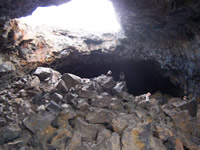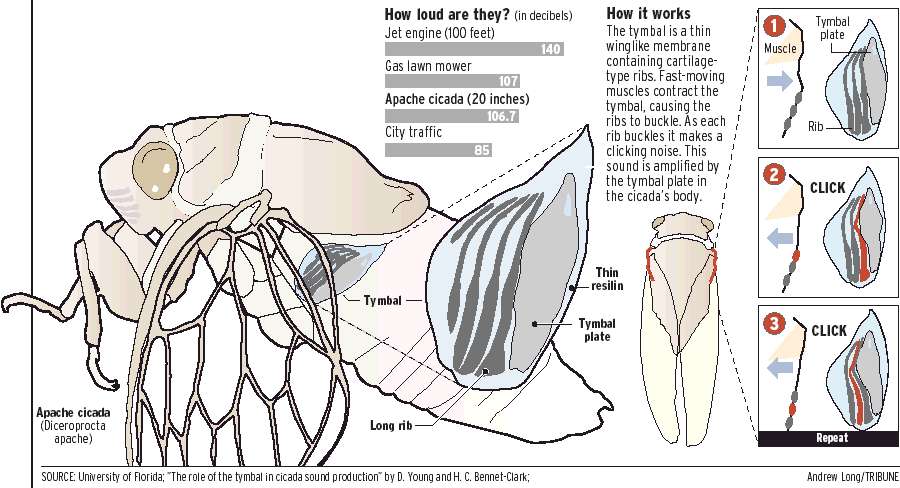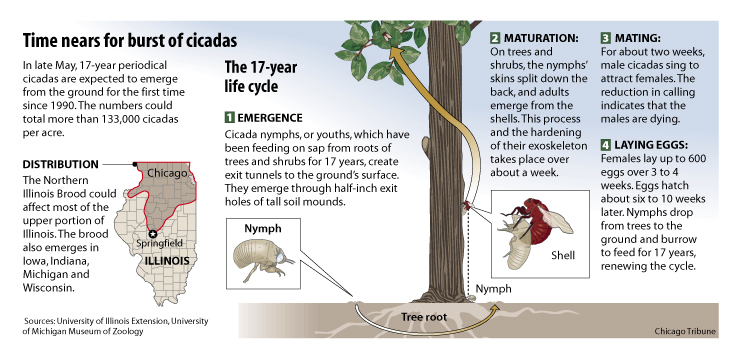Rabid squirrels? Ouch.
Sunday, December 30, 2007
do not park here
Rabid squirrels? Ouch.
Thursday, December 20, 2007
don't feed the parrots in san francisco
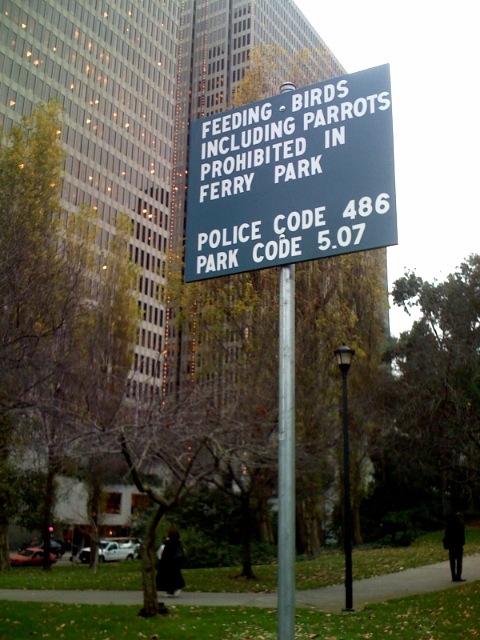
Well, this was not a sign I expected to see in the middle of the city. But it is true - there is a flock of wild parrots that make their home in San Francisco. Actually, there are TWO flocks of birds in the city, but this park is often home to the famous "Wild Parrots of Telegraph Hill." (The scientific name is Aratinga erythrogenys, also known as a cherry-headed conure, among other names.) This species comes from the west side of the Andes in southern Ecuador and the extreme north of Peru.
Resident Mark Bittner maintains a website promoting his book, his film, and general information on these birds. He also was integral in creating this law in 2007, banning the feeding of the birds.
From Bittner's site, I also learned that there is a wild parrot flock in Chicago, Illinois! (First spotted in 1973 in the Hyde Park neighborhood.)
Tuesday, December 11, 2007
merriam-webster's word of the year: w00t
Gamers commonly substitute numbers and symbols for the letters they resemble, Morse says, creating what they call "l33t speak" — that's "leet" when spoken, short for "elite" to the rest of the world.
Is this the first word in the dictionary containing digits? :)
Sunday, December 9, 2007
vegetable orchestra
According to the website, at the conclusion of each performance, the audience is offered bowl of vegetable soup.
Saturday, December 8, 2007
oxford word of the year: locavore
Ready?
It's "locavore."
A "locavore" buys food from farmers’ markets or grows the food him- or herself. This is partially because locavores claim local food tastes better and is healthier, but also to avoid the environmental costs of shipping food over long distances.
“The word ‘locavore’ shows how food-lovers can enjoy what they eat while still appreciating the impact they have on the environment,” said Ben Zimmer, editor for American dictionaries at Oxford University Press. “It’s significant in that it brings together eating and ecology in a new way.”
“Locavore” was coined two years ago by a group of four women in San Francisco who proposed that local residents should try to eat only food grown or produced within a 100-mile radius.(I recently ate at a San Francisco restaurant, Fish and Farm, which focuses on sustainable and organic food. Fish and Farm grows all its own herbs and its produce is organic and sourced within a 100-mile radius. Also, whenever possible, so are their meats. )
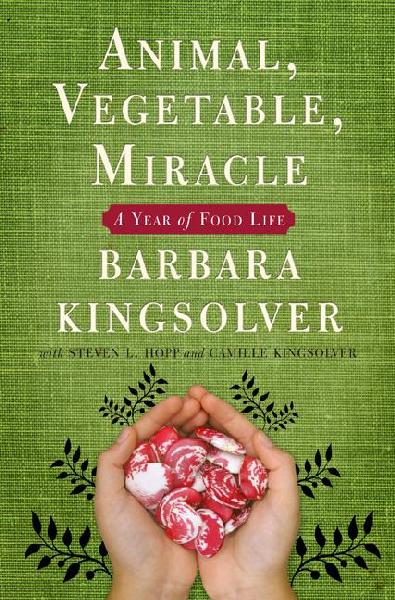 This is especially interesting for me, since I just finished reading Barbara Kingsolver's Animal, Vegetable, Miracle, published in May of this year. A combination of this book and living in California with locavore roommates has ignited my interest in local and seasonal food. The book itself chronicles one family's experience as they move to Appalachia to experiment with eating locally for one year. I found myself laughing at their adventures with squash surplus and turkey sex. But more importantly, I found myself thinking about food seasonally and considering the environmental effects of having bananas in December. (Many people want carbon cost labeling on food products.) Most surprisingly, I found myself trying out the recipes at the end of each chapter. And, I ate a persimmon (seasonal in November) for the first time in my life.
This is especially interesting for me, since I just finished reading Barbara Kingsolver's Animal, Vegetable, Miracle, published in May of this year. A combination of this book and living in California with locavore roommates has ignited my interest in local and seasonal food. The book itself chronicles one family's experience as they move to Appalachia to experiment with eating locally for one year. I found myself laughing at their adventures with squash surplus and turkey sex. But more importantly, I found myself thinking about food seasonally and considering the environmental effects of having bananas in December. (Many people want carbon cost labeling on food products.) Most surprisingly, I found myself trying out the recipes at the end of each chapter. And, I ate a persimmon (seasonal in November) for the first time in my life.Interestingly enough, 2006's Word of the Year was similarly environmentally-themed: carbon-neutral.
Being carbon neutral involves calculating your total climate-damaging carbon emissions, reducing them where possible, and then balancing your remaining emissions, often by purchasing a carbon offset: paying to plant new trees or investing in “green” technologies such as solar and wind power.
Monday, November 5, 2007
global warming halloween costume
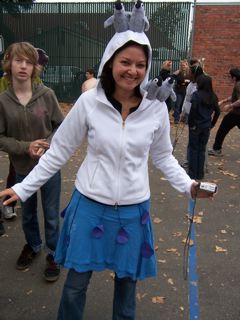 FRONT: You can see the drips on her skirt, the clue that this wasn't your everyday glacier costume. Even though scientists predict that melting ice will not threaten coastal communities for some time, there is incontrovertible evidence that ice is melting at a rapid rate. "Last year Eric Rignot ... calculated that Greenland lost a total of 54 cubic miles (225 cubic kilometers) of ice in 2005, more than twice as much as ten years ago—and more than some scientists were prepared to believe."
FRONT: You can see the drips on her skirt, the clue that this wasn't your everyday glacier costume. Even though scientists predict that melting ice will not threaten coastal communities for some time, there is incontrovertible evidence that ice is melting at a rapid rate. "Last year Eric Rignot ... calculated that Greenland lost a total of 54 cubic miles (225 cubic kilometers) of ice in 2005, more than twice as much as ten years ago—and more than some scientists were prepared to believe."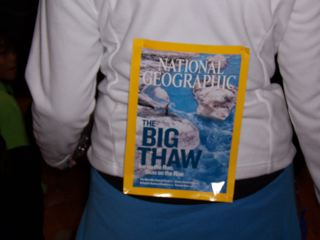 BACK: On her back, she displayed the June 2007 issue of National Geographic entitled The Big Thaw (The magazine also has a pretty cool interactive site where you can learn more about global warming.)
BACK: On her back, she displayed the June 2007 issue of National Geographic entitled The Big Thaw (The magazine also has a pretty cool interactive site where you can learn more about global warming.)It's very interesting teaching in a Berkeley, CA school. The other day, I showed the 3rd grade class part of a YouTube video to introduce them to Rube Goldberg. I explained that I was only showing part of the video, since it was actually a 1940s advertisement for gasoline. ("Fortunately for us, man has discovered a virtually unlimited source of power... gasoline") I mentioned that I thought is was amazing that just 50-some years ago, there was such positive excitement around using oil.
One third grader raised his hand and said, "That's funny because in 2007 we know that burning gas causes pollution and that pollution affects the atmosphere, which causes global warming. So, the ice is melting in places around the world, and some polar animals are losing their habitats." Many kids nodded along. He continued, "But, my family has a hybrid car, so we are trying to make the problem a little bit better." After a bit of discussion, I learned that over HALF of the students had at least one car in the family that was a hybrid, electric, or ran on natural gas. Which reminds me of a sign I saw this weekend at a Berkeley street fair.
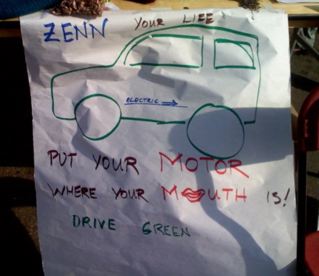
Wednesday, October 31, 2007
Saturday, October 13, 2007
sign: shoplifters will be composted
This sign was nestled in the boxes of dates at the Farmer's Market one Saturday morning.

Monday, October 8, 2007
Saturday, October 6, 2007
Thursday, October 4, 2007
sign: low clearance
This first sign is found in the California Academy of Sciences museum in San Francisco, CA.

Thursday, September 27, 2007
sashimi tabernacle choir OR singing fish car
In fact, the experience inspired my first YouTube video upload. :)
Thursday, September 20, 2007
a lizard in a lizard
 (Imagine my surprise when I realized I already have a previous post about reptiles swallowing unusual things.) Anyway, this story is a new one for me....
(Imagine my surprise when I realized I already have a previous post about reptiles swallowing unusual things.) Anyway, this story is a new one for me....Things got pretty weird in Jacksonville, Florida, when a 7 year old brought her pet 12-inch bearded dragon to the animal hospital. She thought it was having a baby. (This would be a problem, since bearded dragons lay eggs.)
At the animal hospital, veterinarian John Rossi sedated the lizard and began to pull on the obstructions.
"The next thing I knew, I was seeing legs and a body and a head. It was very strange to be tugging on this thing," he said. By the time the rubbery lizard's legs began to appear, Rossi realized what it was.Her pet had swallowed a 7 inch rubber lizard. Whoa. The rubber lizard was a little over 58% the length of the lizard. Imagine if you swallowed a 3 foot rubber human....
"We were all laughing," he said. "It passed completely through the entire (gastrointestinal) tract," Rossi said.
Wednesday, August 29, 2007
toliet paper wedding gown

Well, I thought the duct tape prom dresses were cool, but today I found out there is also a contest sponsored by Cheap-Chic-Weddings.com that challenges contestants to create a "a wedding gown and headpiece that you have constructed out of toilet paper, tape and/or glue ONLY."
Check out these winners from 2007, 2006, and 2005. Impressive.
Sunday, August 26, 2007
how does a word get into the dictionary?
Of course, I always ask, "how does a word make it to the dictionary?"
Many of these words have been around for a while. (In fact, Merriam-Webster traces ginormous back to 1948, when it appeared in a British dictionary of military slang!) However, just because a word is used, doesn't mean it will make it into the dictionary. Editors who work for the dictionary spend a few hours each day reading magazines, newspapers, and electronic publications, checking for new words or variant spellings of existing words.
If they find a word of interest, they will write a citation for it. Later, definers go through the citations and decide which words should be included. It doesn't matter how often a word is cited, because it may only be found in very specific writings (like only scientific journals or only rap lyrics). To be included in a Merriam-Webster dictionary, a word must have a number of citations that come from a many different types of writing over a long period of time. The word must be used long enough and in enough variety such that the word's meaning is clear.
The number and type of citations needed to add a word to the dictionary varies. In some cases, a word comes on fast and widespread, and its meaning is clear and uncontroverted. This was the case in the 1980s with the word AIDS. In such a situation, the editors may decide to include the word, even though it has not been in use for a long period of time.
Still interested? There's even a "new word watch" blog! (Scroll down to view most recent posts.)Wednesday, August 15, 2007
itch mite in chicago
 I have been hearing from a number of folks back home that there is an outbreak of itching in the Chicagoland area. Of course, I am always in the mood for a good arthropod story, so I looked into it. (Ends up the bites are caused by arachnids, though, and not insects!)
I have been hearing from a number of folks back home that there is an outbreak of itching in the Chicagoland area. Of course, I am always in the mood for a good arthropod story, so I looked into it. (Ends up the bites are caused by arachnids, though, and not insects!)"We don't have positive identification on the type of mite that it is. We do know that it is a mite," said Kitty Loewy, spokeswoman for the Cook County Department of Public Health. (Tribune)Monday night, authorities left glue traps in forest preserves and other wooded areas. On Tuesday, they still didn't catch any; they think because the mites are "too small." But anyone bit by these insects are showing the telltale rash that develops 10 - 12 hours after being bitten. (The rash is a reaction to toxins in the mite's saliva as they gnaw on you as they look for larvae that aren't there. The toxin is potent (for insects at least). One mite’s bite can kill an insect larva 170,000 times its own weight.)
In the suburbs, Dr. George Tsoutsias said "Patients were actually comparing their lesions out in the waiting room," said. He saw 32 cases this weekend in the Adventist La Grange Memorial Emergency Department.
Investigators think this outbreak may be caused by an itch mite from Europe—the oak leaf gall mite, Pyemotes herfsi, a relative of the straw itch mite (which farmers have dealt with for years). It feeds on midge larvae in oak trees, falling when it runs out of food, often right onto people passing below. Scientists say these European arthropods may have hitched a ride here due to increased worldwide shipping and transportation that moves new species around the world. Kansas knows all about this, since they dealt with an outbreak in 2004. (The Pittsburg State University has a site with plenty of pictures and Quicktime videos of both the bites and the bugs.)
Information provided by entomologists indicated that these mites were associated with a gall-forming insect (a small fly called a "midge") that causes swellings along veins of oak leaves.The female midges lay eggs on the leaf surface, and the young midges crawl to the edge of the leaf or along a vein where they secrete chemicals that cause the leaf tissue to curl up into a cylinder-like gall protecting the midge larvae inside.
The itch mites prey on these midges, invading the galls, where they feed on the midge larvae and begin to reproduce. Each female mite can produce up to 250 adult offspring, most of which are females. Each generation requires only seven days, which helps explain the large population numbers that have been encountered where the problem has been serious. (like Chicago right now)
Kansas State University describes the mites' bizarre life cycle as they researched the 2004 Kansas outbreak:
The mite’s life cycle is unusual. A mated female searches for a host on which to feed. She is small enough to be carried by the wind. If she finds a rolled leaf (gall) on an oak tree, she enters the gall. If she finds midge larva, she inserts her mouthparts into the larva. Within minutes, a potent neurotoxin in her saliva paralyzes the midge larva, who will die of starvation.
Once the female starts to feed, she can develop as many as 250 offspring. In seven days, her “abdomen” is fully distended, and her young -- of which only 5 to 10% are males -- are ready to emerge as fully developed adults. Males emerge ahead of the females, and mate with the females as they emerge from the mother and die shortly after. The females complete the cycle by dispersing in search of new hosts.
Luckily, the bites are not medically dangerous, just annoying (see video), unless people scratch enough to damage their skin, allowing bacteria to get in and cause a secondary infection. Unfortunately, bites can continue to itch for 10 - 14 days. To prevent the bites, scientists suggest wearing long clothing and insect repellent with DEET while outside, and washing clothes immediately after coming indoors. To treat them, doctors recommend using hydrocortisone cream and antihistamine.
At first, some people were hypothesizing that the outbreak had something to do with the cicada emergence earlier this summer (maybe the cicada larvae are a food source since they hatch 6-10 weeks after being deposited in the branches, and fall to the ground? Gross.). But, according to NBC, seven other states are dealing with similar outbreaks. They are Texas, Nebraska, Kansas, Missouri, Ohio and Kentucky, so this is probably not the case. (The cicadas were mostly in northern Illinois and southern Wisconsin.)
UPDATE (Chicago Tribune 12/15): I guess sometimes these mites COULD munch on cicada larvae. Field Museum entomologist Daniel Summers says the mite also finds immature members of the Homoptera family to be delectable, he said.
That family includes the periodic cicadas, the noisy bugs that flooded the Chicago area to mate earlier in the summer. The next generation of nymphs are emerging now, presenting an irresistible food source to any Pyemotes mite looking for something to eat.
"They're hatching out right now in the forest preserves by the countless zillions," Summers said. "It would be an endless feast for them. That would be my best guess right now."
Monday, August 6, 2007
mccarrots taste better?
 Now, you may have already heard this one on the news, but it's pretty incredible. The August issue of the Archives of Pediatrics & Adolescent Medicine published an article demonstrating the power of advertising to small children. (You can read more about this study in Forbes or the Associated Press)
Now, you may have already heard this one on the news, but it's pretty incredible. The August issue of the Archives of Pediatrics & Adolescent Medicine published an article demonstrating the power of advertising to small children. (You can read more about this study in Forbes or the Associated Press) By the early age of 3 to 5 years, low-income preschool children preferred the tastes of foods and drinks if they thought they were from McDonald’s, demonstrating that brand identity can influence young children's taste perceptions. - Pediatr Adolesc Med.
I was a little surprised the San Mateo County, CA experiment was limited to low-income kids, but the study author, Dr. Tom Robinson, allegedly believes the results would be similar for children from wealthier families.
Five foods were tested. The chicken nuggets, hamburger and french fries were all from McDonald's; the carrots and milk were from a grocery store. Kids sat behind a white screen, and were handed two identical samples of food, one coming out of a plain paper bag, wrapped in plain paper, while the other came out of a McDonald's bag, wrapped in similarily-labeled paper. If kids did not immediately recognize the symbol (around 25% of the time), a researcher would tell them which one was from McDonald's.
The independent variable in this case was the packaging for the food, while the dependent variable was the kid's preference of food. (Kids also had the option of saying the two samples tasted the same.) The researchers made great efforts to control their experiment, I recommend reading the methods section of the study to read the details. In fact, the whole study is pretty intense. For such a simple-sounding experiment, there is still a lot of serious scientific method involved. The write-up includes statements such as, "The 63 children performed a total of 304 individual tasting comparisons. Three, 2, 3, 1, and 1 child were not allowed to eat hamburger, chicken nuggets, french fries, milk, and carrots, respectively, and 1 child was unable to bite the carrots. "
The results?
- 77 percent said the labeled fries tasted best while only 13 percent preferred the others
- 54 percent preferred McDonald’s-wrapped carrots versus 23 percent who liked the plain-wrapped sample
- The only results that were not overwhelmingly clear involved the hamburgers, with 29 kids choosing McDonald’s-wrapped burgers and 22 choosing the unmarked ones.
- Less than 25% of the children said both samples of all foods tasted the same.
Finally, the whole things makes me consider the power of advertising in older kids (and adults). All I have to do is consider fads like Ugg boots....
Wednesday, July 25, 2007
underwater restaurant in the maldives
 Did you know there is a restaurant completely underwater? (This is the strangest thing I have heard about since the first ice hotel!)
Did you know there is a restaurant completely underwater? (This is the strangest thing I have heard about since the first ice hotel!)The Ithaa Restaurant (Ithaa means “pearl” in the

Tuesday, July 24, 2007
sony bravia 's exploding colors
To announce the arrival of the BRAVIA LCD and 3LCD range, we wanted to get across a simple message - that the colour you'll see on these screens will be 'like no other'. - Bravia site
AMAZING / CRAZY COMMERCIAL #1: BALLS
 So, the first commercial (filmed in 2005) features 250,000 superballs, a kid, and one frog. It took 23 people to film and "only one chance to get [the main sequence] right". With a combination of trucks and air cannons, the balls were released. Although pretty to look at, "these balls can do some damage, so all the cars were props and crew members went so far as to having protective shields and crash helmets."
So, the first commercial (filmed in 2005) features 250,000 superballs, a kid, and one frog. It took 23 people to film and "only one chance to get [the main sequence] right". With a combination of trucks and air cannons, the balls were released. Although pretty to look at, "these balls can do some damage, so all the cars were props and crew members went so far as to having protective shields and crash helmets."Watch the BALLS commercial.
See behind-the-scenes.
Read more about it.
Read about the British soft drink's spoof of the ad.
AMAZING / CRAZY COMMERCIAL #2: PAINT
 This one (July 2006) was filmed in Glasgow, Scotland and took 10 days, 250 people (to film), and 70,000 liters of paint. (The cleaning took 5 days and 60 people!) And of course, as in all experiments, "safety first."
This one (July 2006) was filmed in Glasgow, Scotland and took 10 days, 250 people (to film), and 70,000 liters of paint. (The cleaning took 5 days and 60 people!) And of course, as in all experiments, "safety first."Keeping everyone safe was also an important factor. A special kind of non-toxic paint was used that is safe enough to drink (it contains the same thickeners that are sometimes used in soups). It was also completely harmless to the skin.
Watch the "PAINT" commercial.
See behind-the-scenes.
Read more about it.
If I watched TV, these ads might make me go buy one. :)
Friday, July 20, 2007
my first earthquake
According to the USGS, "Each year the southern California area has about 10,000 earthquakes. Most of them are so small that they are not felt. Only several hundred are greater than magnitude 3.0, and only about 15-20 are greater than magnitude 4.0. " Although San Francisco is not exactly southern California, the general idea is the same. There are many microquakes each day, but this morning's quake was an unusual one. (In fact, according to the USGS site right now, in the 12.5 hours since this morning's quake, there already have been 11 more earthquakes in California today!)
Earthquakes, as most of you know, are a consequence of moving tectonic plates and are measured using the Richter scale.
The Richter scale is a standard scale used to compare earthquakes. It is a logarithmic scale, meaning that the numbers on the scale measure factors of 10. So, for example, an earthquake that measures 4.0 on the Richter scale is 10 times larger than one that measures 3.0. On the Richter scale, anything below 2.0 is undetectable to a normal person and is called a microquake. Microquakes occur constantly. Moderate earthquakes measure less than 6.0 or so on the Richter scale. Earthquakes measuring more than 6.0 can cause significant damage. The maximum quake rating ever measured is about 8.9. - HowStuffWorks
Wednesday, July 11, 2007
science across the usa
 The Badlands (South Dakota) - This national park consists of nearly 244,000 acres of some of the most bizarre landforms I have ever seen. Here, rivers and rainstorms have been eroding away the soft sediments and volcanic ash, revealing colorful bands that correspond with specific time periods in the history of the rock formation.
The Badlands (South Dakota) - This national park consists of nearly 244,000 acres of some of the most bizarre landforms I have ever seen. Here, rivers and rainstorms have been eroding away the soft sediments and volcanic ash, revealing colorful bands that correspond with specific time periods in the history of the rock formation.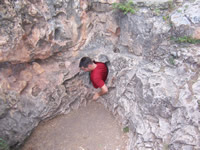 Wind Cave (South Dakota) - First explored by a 16 year old boy with a candle and a string, Wind Cave now has over 100 miles of known passageways, although studies indicate only about 5% of the cave has been discovered.
Wind Cave (South Dakota) - First explored by a 16 year old boy with a candle and a string, Wind Cave now has over 100 miles of known passageways, although studies indicate only about 5% of the cave has been discovered.The most fascinating part of the cave is its entrance. The Lakota Indians have been long aware of this opening, and regard it as a sacred place. In the picture to the left, you can see a guy attempting to enter the natural entrance of the cave. (I guess he didn't care about the gate park rangers have installed to stop people from doing just that....) It is this opening (and not the cave's interior) that gives Wind Cave its name.
The wind moves depending on atmospheric pressure on the surface and inside the cave. When the pressure is higher outside than inside the cave, wind rushes into the entrances; when pressure is higher inside the cave, the wind blows out of the entrances.
This was confirmed on our visit by the presence of ominous clouds in the distance (storm approaching) and the strong winds blowing out of the natural entrance.The wind is driven by changes in barometric pressure. The air pressure within the cave and outside attempt to reach equilibrium. The wind blows into the cave when the barometer rises, and out when the barometer falls. This airflow may forecast how the weather is going to change. - nps.gov
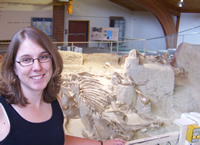 Mammoth Site (South Dakota) - More than 26,000 years ago, many large Colombian and woolly mammoths spent their time tediously scraping away the snow with their tusks to find food. However, scientists believe some mammoths were "lazy" and were instead lured by the more easily-accessible vegetation at the sinkhole's edge. Once these mammoths risked coming near the sinkhole's edge, it is believed they fell in, became trapped and died.
Mammoth Site (South Dakota) - More than 26,000 years ago, many large Colombian and woolly mammoths spent their time tediously scraping away the snow with their tusks to find food. However, scientists believe some mammoths were "lazy" and were instead lured by the more easily-accessible vegetation at the sinkhole's edge. Once these mammoths risked coming near the sinkhole's edge, it is believed they fell in, became trapped and died.Scientists have found remains of 52 mammoths in the pit (which was discovered by chance in 1974 when they bulldozed to make a housing development). Of those 52 animals, ALL of them are male. And all, except one, are young ADOLESCENT males. Raleigh Philip, author of an educational neuroscience text, says, "It's interesting to speculate how the young Colombian Mammoths' adolescent brain may have led to their demise in the same way that teenagers take risks today."
 Devil's Tower (Wyoming) - Geologists agree that Devils Tower is the core of a volcano exposed after millions of years of erosion. However, there is still debate about the exact details of its formation. This bizarre land form has been somewhat of a mystery. Perhaps that is why Stephen Spielberg used Devil's Tower as an alien communication point in his movie Close Encounters of the Third Kind.
Devil's Tower (Wyoming) - Geologists agree that Devils Tower is the core of a volcano exposed after millions of years of erosion. However, there is still debate about the exact details of its formation. This bizarre land form has been somewhat of a mystery. Perhaps that is why Stephen Spielberg used Devil's Tower as an alien communication point in his movie Close Encounters of the Third Kind.Also known as Bears Lodge, it is a sacred site for many American Indians. I personally like their legend the best.
In one story, two girls playing in the woods are chased by an enormous bear. The girls jump on top of a rock, but it is too small to give them safety. The Great Spirit sees the girls' predicament and causes the rock to grown to an immense size. The giant bear jumps at the girls, but cannot reach the top. His claws leave the gouges in the side of the rock that can still be seen today. - the Unmuseum
 Beehive Geyser (Yellowstone Nat'l Park, Wyoming) - While Old Faithful is certainly the most famous geyser at Yellowstone, it is just one of the 10,000 geothermal features found in the park. The geyser in the picture is Beehive Geyser, an unpredictable cone geyser with water reaching 93 °C (199 °F) and eruptions up to 200 feet! A cool thing about this geyser is that there is a small vent located a few feet east of Beehive, called Beehive's Indicator, which erupts about 6 feet, 10-20 minutes before an eruption. When we walked by the sputtering indicator, we decided to stick around for the show!
Beehive Geyser (Yellowstone Nat'l Park, Wyoming) - While Old Faithful is certainly the most famous geyser at Yellowstone, it is just one of the 10,000 geothermal features found in the park. The geyser in the picture is Beehive Geyser, an unpredictable cone geyser with water reaching 93 °C (199 °F) and eruptions up to 200 feet! A cool thing about this geyser is that there is a small vent located a few feet east of Beehive, called Beehive's Indicator, which erupts about 6 feet, 10-20 minutes before an eruption. When we walked by the sputtering indicator, we decided to stick around for the show!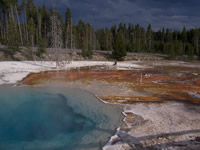 Yellowstone Nat'l Park, (Wyoming) - Thermophiles, or microbes that live in extremely hot conditions, make up these colorful bacterial mats. Pigments (like chlorophyll and carotenoids) within the microbes are responsible for their colors. The run-off channel from a hot spring, for example, is white or clear near its source. This water is heated by the magma just under the earth's crust! Only a few single-cell bacteria live in this boiling water, which is 93 °C (199°F). (Pure water boils at 212°F at sea level.) As the water slightly cools to 167°F farther downstream, the first colorful forms of bacteria show up. Shades of green to pink to orange to yellow-brown to gray indicate bacteria growing in slightly different temperature regions on the mat.
Yellowstone Nat'l Park, (Wyoming) - Thermophiles, or microbes that live in extremely hot conditions, make up these colorful bacterial mats. Pigments (like chlorophyll and carotenoids) within the microbes are responsible for their colors. The run-off channel from a hot spring, for example, is white or clear near its source. This water is heated by the magma just under the earth's crust! Only a few single-cell bacteria live in this boiling water, which is 93 °C (199°F). (Pure water boils at 212°F at sea level.) As the water slightly cools to 167°F farther downstream, the first colorful forms of bacteria show up. Shades of green to pink to orange to yellow-brown to gray indicate bacteria growing in slightly different temperature regions on the mat.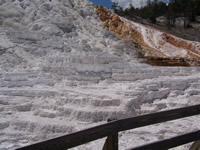 (Yellowstone Nat'l Park, Wyoming) - At the Mammoth Hot Springs, I learned that these white tiered formations were travertine. This mineral is formed when hot water dissolves the limestone beneath Mammoth and brings it to the surface where it cools, and and forms this delicate mineral. These terraces (in the picture) are like "living sculptures," since they can change with changes in temperature, water flow, and bacterial concentrations. (Notice the colorful thermophile bacteria mat in the background.)
(Yellowstone Nat'l Park, Wyoming) - At the Mammoth Hot Springs, I learned that these white tiered formations were travertine. This mineral is formed when hot water dissolves the limestone beneath Mammoth and brings it to the surface where it cools, and and forms this delicate mineral. These terraces (in the picture) are like "living sculptures," since they can change with changes in temperature, water flow, and bacterial concentrations. (Notice the colorful thermophile bacteria mat in the background.) Mud Pots! (Yellowstone Nat'l Park, Wyoming) - I was somewhat familiar with hot springs before my Yellowstone trip, but I was was never introduced to their close cousins, the fumarole and the mudpot. The mudpots quickly became my favorite geothermal feature, mostly due to their "bloop bloop" sounds. A mudpot or paint pot is a sort of hot spring or fumarole consisting of a pool of usually bubbling mud. Watch my Quicktime video to see a mudpot hurling mud into the air.
Mud Pots! (Yellowstone Nat'l Park, Wyoming) - I was somewhat familiar with hot springs before my Yellowstone trip, but I was was never introduced to their close cousins, the fumarole and the mudpot. The mudpots quickly became my favorite geothermal feature, mostly due to their "bloop bloop" sounds. A mudpot or paint pot is a sort of hot spring or fumarole consisting of a pool of usually bubbling mud. Watch my Quicktime video to see a mudpot hurling mud into the air.Craters of the Moon (Idaho) - I saw fields of lava, both áa ("ay-ay") and pahoehoe ("pa-hoy-hoy") lava. (I liked the sound of those names!) The highlight of this visit had to be exploring the caves formed by the collapse of giant lava tubes. The tubes were originally formed as hot lava melted and rock in its path, while the surface of the lava in contact with the air hardened (forming the "roof" of the cave). When these tubes collapsed, they made great caves to explore!
Finally, I couldn't resist... this picture is one of my favorites from the trip. You don't see this in Chicago!

Sunday, June 17, 2007
what the world eats
 Speaking of food, there is an amazing photo gallery from Time Magazine. (It is based of a book called Hungry Planet.) Each of the 15 photos show family members standing around the food that would make up a series of typical meals for the week, plus the weekly cost and a list of their favorite foods.
Speaking of food, there is an amazing photo gallery from Time Magazine. (It is based of a book called Hungry Planet.) Each of the 15 photos show family members standing around the food that would make up a series of typical meals for the week, plus the weekly cost and a list of their favorite foods.Not surprisingly, the most processed food surrounds... you guessed it. The American families. This is even more intriguing to me as I am currently reading An Omnivore's Dilemma. This book discusses the food processing that I (and many Americans) seldom consider. (For instance, did you know there are 38 ingredients required to make a Chicken McNugget?!) If you are not so interested in reading the entire book, you could check out the article author Michael Pollan wrote in the New York Times. Some of his advice includes:
Eat food. Though in our current state of confusion, this is much easier said than done. So try this: Don’t eat anything your great-great-grandmother wouldn’t recognize as food. (Sorry, but at this point Moms are as confused as the rest of us, which is why we have to go back a couple of generations, to a time before the advent of modern food products.) There are a great many foodlike items in the supermarket your ancestors wouldn’t recognize as food (Go-Gurt? Breakfast-cereal bars? Nondairy creamer?); stay away from these.
Especially avoid food products containing ingredients that are a) unfamiliar, b) unpronounceable c) more than five in number — or that contain high-fructose corn syrup.None of these characteristics are necessarily harmful in and of themselves, but all of them are reliable markers for foods that have been highly processed.
Saturday, June 9, 2007
food hacking
What happens when the world's leading hacker chefs skill up on organic chemistry and buy centrifuges for their kitchens? Is your palate ready for "meat glue", "cooking" with liquid nitrogen, and "liquid noodles"? ... [this] looks at the growing role of science in fine dining kitchens with examples from the restaurants that are inventing the exciting field of molecular gastronomy. (Dorkbot)I am a terrible cook, and usually consume food I can carry in one hand (apple, bagel, rice cake). However, my interest in food preparation was piqued when I read about food hacking! This trend, popularized by scientifically-minded chefs, is based on the principle of "creat[ing] dishes based on the molecular compatibilities of foods." For example, a food hacker might combine chocolate and oysters (!) due to the similarities in their molecular make-up.
Marc Powell, a San Francisco-based hacker chef, is well known in the field of "molecular gastronomy." His website (foodhacking.com) established a food hacking wiki in June of 2006, where fellow food hackers can go to share ideas and "Experiments/recipes." Many of the recipes require unusual tools such as a nitrous oxide siphon or a centrifuge. Other recipes require exotic chemicals, like "meat-glue" which can combine chicken and beef into a single slab of meat referred to as "chick-a-beef."
Martin Lersch, from Oslo, Norway, holds a PhD within the field of organometallic chemistry and maintains a blog about molecular gastronomy and the connections between science and cooking.
Here in Chicago, interested parties can experience molecular gastronomy bliss at Moto (google map).

You don't just eat chef Homaro Cantu's food. You gape in disbelief as you are instructed in how to handle his offbeat creations with even more peculiar utensils: The whole thinking is like a three-star science lab. (from one of many reviews of the restaurant)
Wednesday, June 6, 2007
moving giant marine animals
 Well, the two whale sharks were flown 8,000 miles from Taipei, Taiwan on a specially-designed cargo plane with 20-foot-long fiberglass tanks with oxygen machines and other equipment to keep them healthy on their trip. When they arrived in Atlanta, Georgia, their tanks were transferred to two flatbed trucks and driven to the aquarium surrounded by an escort of Atlanta police cars with their blue lights flashing. (video) They will join three other whale sharks in their new home in a 6 million gallon tank.
Well, the two whale sharks were flown 8,000 miles from Taipei, Taiwan on a specially-designed cargo plane with 20-foot-long fiberglass tanks with oxygen machines and other equipment to keep them healthy on their trip. When they arrived in Atlanta, Georgia, their tanks were transferred to two flatbed trucks and driven to the aquarium surrounded by an escort of Atlanta police cars with their blue lights flashing. (video) They will join three other whale sharks in their new home in a 6 million gallon tank.Qannik, the male Beluga whale born back in August, 2000, is leaving Chicago and heading for Tacoma, Washington's Point Defiance Zoo. Qannik's mother, Mauyak, is pregnant again and expecting the new calf this fall. The mother/son bond between Qannik and Mauyak has all but disappeared as he grows into a sexual mature adult, and he must leave the facility to avoid interbreeding between him and his mother. Qannik is now 11 feet long and weighs about 1,000 pounds. In his new home, he will live in a whale pool with Beethoven, a 14-year-old 1,600-pound male beluga.
Qannik will travel in a specially-designed freight plane, riding in a "custom-made, fleece-lined sling suspended in a shallow tank of ice water." Trainers at the Shedd have been putting Qannik in and out of the sling repeatedly this year, using it for check-ups and exams, which will help Qannik be more comfortable with the device during his trip.
UPDATE (6.11.07) Qannik has arrived at the Tacoma zoo!
The aquarium kept the timing of Qannik's move under wraps to stave off protests, officials told The News Tribune of Tacoma for a story posted on the paper's Web site Sunday.
The whale traveled inside an "enormous, foam-padded plastic tank in the DC-8 plane for a flight that cost $84,000." The zoo website has posted photos of Qannik's adventures!
Tuesday, June 5, 2007
so many deformed cicadas
John Cooley, a biologist at the University of Connecticut says it is not the lawn chemicals doing the damage, although humans are the ultimate culprit.
When cicada nymphs emerge, they must find something vertical to climb and stake out perching places to molt. At its perch, each cicada slips out of its nymph shell and then must hang undisturbed on that perch until its new exoskeleton unfolds and begins to harden properly. If it is disturbed during that time, its exoskeleton will be deformed ("faulty ecdysis," to the scientists).
In regular woody settings, there are plenty of trees, shrubs and tall grasses to support the cicada population. But here in the suburbs, yards are carefully landscaped, with neatly trimmed lawns and a few strategically placed trees and bushes, which limits the number of perches for the nymphs to hang on.
Since many cicadas must crawl onto the same places, they often bump into or climb over each other. This is a problem for those light-colored, recently molted cicadas who are waiting for their exoskeletons to harden. At the delicate stage when they must hang undisturbed, they are finding themselves trampled by other cicadas. This causes the many deformed cicadas.
The University of Connecticut Dept. of Ecology agrees, "Cicadas sometimes fail to properly inflate their wings after molting; such individuals can be found in low vegetation in any emergence.... The cicadas in the picture below came from a 1990 emergence in a suburban front yard near Chicago. Many of the cicadas in this area had deformed wings. Possible explanations include crowding (during molting) and use of lawn chemicals."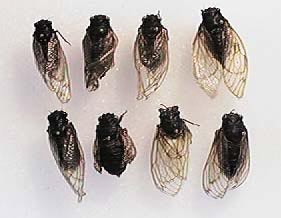
A University of Illinois entomologist believes it is normal to have so many deformed cicadas, although normally predators would eat them before we would see them. However, with these cicadas, there are so many insects, the predators can't keep up! (Chicago Cicada Central)
Wednesday, May 30, 2007
our ginkgo tree
The word Ginkgo comes from a misspelling of the Japanese word "ginkyo" or "silver apricot." Other people attribute the word to the older Chinese word meaning "silver fruit."
Not that you'd want to hang around the fruit of the female ginkgo tree. While most plants are hermaphrodites, ginkgos have separate male and female trees. The female trees produce fruit that become a mushy, foul-smelling mess on city sidewalks in the fall. The fruit contains butanoic acid, which makes it smell like rancid butter. For this reason, landscape suppliers will only sell male cultivars, or trees that are male clones of existing trees, to ensure maleness. Don't know if your Ginkgo is male or female? Don't let a few years of non-smelliness convince you - female trees will not fruit for 20 years more. (Ours is a male cultivar.)
Ginkgos are deciduous dioecious gymnosperms (deciduous = they lose leaves yearly, dioecious = male and female are separate, gymnosperm = "naked seed," meaning their seeds are not encased in ripened fruit, although the females do not produce actual cones.)
Kingdom Plantae -- Plants
Subkingdom Tracheobionta -- Vascular plants
Superdivision Spermatophyta -- Seed plants
Division/phylum Ginkgophyta -- Ginkgo
Class Ginkgoopsida
Order Ginkgoales
Family Ginkgoaceae -- Ginkgo family
Genus Ginkgo L.

The only living member of the Order Ginkgoales is the Ginkgo biloba! The word biloba means "two-lobed" and refers to its distinctive leaf shape.
Many people take Ginkgo biloba extracts (widely available at drugstores) for a variety of health issues, however, most often as a memory enhancer (to improve memory). "Some smaller studies for memory enhancement have had promising results, but a trial sponsored by the National Institute on Aging of more than 200 healthy adults over age 60 found that ginkgo taken for 6 weeks did not improve memory," as reported in a 2002 JAMA article.
SOURCES: Ohio State Horticulture Page, National Institute of Heath (NIH) Ginkgo Fact Sheet, The Ginkgo Pages.
Saturday, May 12, 2007
bad day at the fish farm
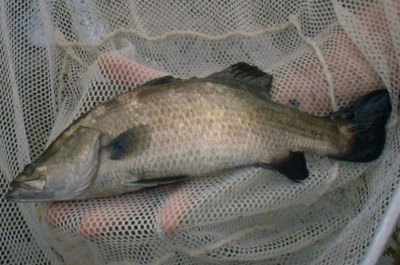 If I ever think I'm having a bad day at work, I will think of this story. Four workers in Turners Falls, Massachusetts fell into a 18-foot filtration tank filled with a mixture of sandy fish feces. The workers were standing on a pad, attached to the tank by a bracket, when the bracket broke, plunging them into the vat of fish waste. The men were rescued, treated and expected to be fine.
If I ever think I'm having a bad day at work, I will think of this story. Four workers in Turners Falls, Massachusetts fell into a 18-foot filtration tank filled with a mixture of sandy fish feces. The workers were standing on a pad, attached to the tank by a bracket, when the bracket broke, plunging them into the vat of fish waste. The men were rescued, treated and expected to be fine.Turners Falls Fire Capt. David Dion comments, "It was very slimy and it was heavy," he said. "Never seen anything like it in my life."
The Australis Aquaculture fish farm in Turners Falls farms barramundi, a replacement for grouper. While we're on the topic, did you ever think of where your fish comes from? There are two types, wild and farm-raised. While fishing fish in the wild can quickly destroy ecosystems (think Happy Feet), farm-raised fish can cause similar havoc.
According to a 2002 article in Time Magazine, aquaculture (as opposed to agriculture) is already the world's fastest-growing food industry, with production increasing more than 10% a year. This is good because "about half the world's wild fisheries have been exhausted by overfishing. In the North Atlantic, one of the most depleted oceans, populations of popular fish are just one-sixth of what they were a century ago." Theoretically, when you eat farm-raised fish, you are saving a wild fish from being removed from the wild.
In fact, ecologists and economists warn that, at the current rate without any changes, the world will run out of seafood by 2048. According to the Washington Post, "the journal Science, concludes that overfishing, pollution and other environmental factors are wiping out important species around the globe, hampering the ocean's ability to produce seafood, filter nutrients and resist the spread of disease."
However, there are many critics of fish farming. According to that same Time article, Otto Langer, a biologist who worked 30 years for Canada's Department of Fisheries, says "a large salmon farm may pour as much liquid waste into the sea as a small city." Not only can fish farms contribute to polluting the waters, but they deplete the supply of wild fish in order to feed their farm-raised counterparts. This leads to some pretty unnatural stuff.
Because salmon are voracious eaters of smaller species, it takes several pounds of wild fish, ground up into meal, to yield 1 lb. of farmed salmon — an exchange that depletes the world supply of protein. The diet of farmed salmon lacks the small, pink-colored krill that their wild cousins eat, so the flesh of farmed fish is gray; a synthetic version of astaxanthin, a naturally occurring pigment, is added to the feed.Also consider the effects of disease, parasites, severe overcrowding of fish, and the antibiotics (farmers give to protect their fish) leaking into the waters.. Also there are potential problems when farm-raised fish escape into the wild, interfering with the natural ecological balance of the area.
Shrimp are particularly damaging to the environment. Shrimp farms can actually raise the salinity of surrounding waters, and the waste run off can kill trees in area. Interestingly enough, Time has some praise for particular invertebrate farms.
On an eco-friendly scale, bivalves generally rate highest among the more than 220 species of fish and shellfish that are cultivated commercially. Mussels and oysters are filter-feeders that make the surrounding water cleaner, so small-scale farming of them is not usually harmful to the ecosystem.
Tuesday, April 10, 2007
the cicadas are coming
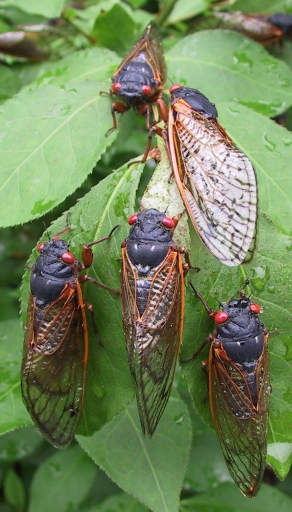 Brace yourselves, Chicagoland, because the cicadas are back! The Chicago Tribune recently published an article about the upcoming infestation of cicadas (which happen to be in the Arthropod phylum).
Brace yourselves, Chicagoland, because the cicadas are back! The Chicago Tribune recently published an article about the upcoming infestation of cicadas (which happen to be in the Arthropod phylum).Cicadas are often mistaken for locusts, but they're actually they are related to leafhoppers or aphids. (Watch a video of actual locusts here.) Locusts are grasshoppers that often travel in vast swarms. Because periodical cicadas appear in such large numbers, early European settlers in North America connected cicadas to the plague of locusts mentioned in the Bible. Cicadas are not locusts.
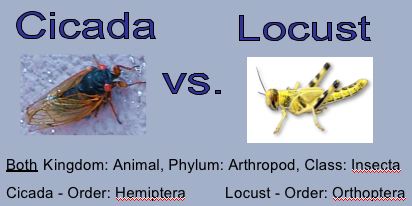
There are some great articles to help you learn how cicadas work. Basically, they work on a 17 or 13 year life cycle. They won't hurt you. Cicadas do not sting or bite, and their diet consists of the sap from plants. The very loud sound you will hear (mostly during the heat of the day) is actually the mating call of the male cicadas. The sound is not produced by vocal chords, but rather by the buckling of the ribs, the vibration of a membrane and amplification in the cavities of the cicada's abdomen. (You can visit the University of Michigan zoology site to find audio files from various types of cicadas.)
After they sing, the cicadas mate. Afterwards, adult female cicada lay eggs by piercing plant stems and inserting the eggs into the slit created in the stem. The eggs eventually hatch into small, wingless cicadas known as nymphs. The nymphs eventually fall to the ground and dig below the surface. Here they stay for 17 years, slowly growing into adults. The nymphs live on the sap from plant roots while they grow. When the nymphs reach full size, they dig their way to the surface with specially adapted front legs that act as tiny shovels. The nymphs then climb to higher ground and shed their skin for the last time. (see YouTube video) Now they are fully-winged adult cicadas. - How Stuff Works
The last brood to emerge was Brood X (brood #10), which came up in the spring of 2004 in the eastern US. The group of cicadas that will be seen in Chicago this May are named Brood XIII (or brood #13). The last time they surfaced (if you do a little mental math) was in 1990, when I was a freshman in high school! Hey, to celebrate this historic moment in your middle school lives, you may want to order your Brood XIII T-shirts now!
They will surface when the ground temperature reaches about 60 degrees Fahrenheit. With any luck, they will be here just in time for all those Memorial Day picnics....
More information on Brood XII (and local cicada events) can be found on the following sites:
Great presentation from Indiana University
The Lake County Forest Preserve
The University of Illinois Cicada Page
ABC News (with video)
Cicada Mania
And, it's not very nice, but you can play Swat the Cicada on your computer.
The University of Maryland even provides cicada recipes for your dining pleasure. It is said they taste like asparagus or clam-flavoured potato.NPR posts just one of their many recipes: (whoa - read the "before you begin")
Disclaimer: the University of Maryland does not advocate eating cicadas without first consulting with your doctor. While many people do eat cicadas, there is no guarantee that they are safe for every person to eat. As with all foods, it is possible that certain individuals will have allergic reactions to substances within the cicada.
Soft-Shelled Cicadas
Ingredients:
1 cup Worcestershire sauce
60 freshly emerged 17-year cicadas
4 eggs, beaten
3 cups flour
Salt and pepper to season the flour
1 cup corn oil or slightly salted butter
Directions:
Marinate cicadas alive in a sealed container in Worcestershire sauce for several hours. (Note: You can skip this step and go directly to the egg step instead.)
Dip them in the beaten egg, roll them in the seasoned flour and then gently sauté until they are golden brown.
Thursday, April 5, 2007
$25 million global warming prize
 A British billionaire Richard Branson teamed up with Al Gore to offer a $25 million prize to anyone who can develop a way to remove carbon dioxide gas from our atmosphere.
A British billionaire Richard Branson teamed up with Al Gore to offer a $25 million prize to anyone who can develop a way to remove carbon dioxide gas from our atmosphere. Another article tells that "Scientists have been looking into removing the greenhouse gas from the atmosphere and storing it in oil and gas fields, injecting it deep into the ocean, or chemically transforming it into solids or liquids that are thermodynamically stable."Gore and Branson said that although scientists are working on technologies to capture carbon dioxide and other greenhouse gases at power plants and other industrial sources, no one has developed a strategy to remove gases already released into the atmosphere.
The winner of the contest must devise a plan to remove greenhouse gases from the atmosphere without creating adverse effects. The first $5 million would be paid upfront, and the remainder of the money would be paid only after the program had worked successfully for 10 years.
So what exactly is up with all this talk about "greenhouse gases" like carbon dioxide?
 The greenhouse effect is responsible for the Earth being warm and for us being able to live there. Gases in the atmosphere surround the earth and trap heat, just like the glass in a greenhouse traps heat for plants and flowers. The Earth is about 60° F warmer than it would be without these protective gases.
The greenhouse effect is responsible for the Earth being warm and for us being able to live there. Gases in the atmosphere surround the earth and trap heat, just like the glass in a greenhouse traps heat for plants and flowers. The Earth is about 60° F warmer than it would be without these protective gases.
“Greenhouse gases” take in any extra radiation and release more heat, which also raises the temperature of the Earth's surface. This is how greenhouse gases “trap” heat to warm our planet.
Or, if you prefer, watch this animated guide to the greenhouse effect.
Greenhouse gases include carbon dioxide, water vapor and ozone. Carbon dioxide makes up almost 84% of all the greenhouse gases we produce. And guess how we produce it?
➢ burning gasoline to drive cars and trucks
➢ burning oil, coal or wood to produce electricity for heating, cooling, and other purposes
➢ burning forests to clear land
Since I do not foresee us not driving cars, building buildings or heating and cooling our homes, maybe Branson has a good idea. If getting people to stop producing carbon dioxide is a daunting task, why not develop ways to get rid of it once we produce it? NASA/World Book has great information about alternative energy sources (not creating so much carbon dioxide) and carbon sequestration (getting rid of it once we produce it).
Anyone looking for $25 million can get more information here.
Wednesday, March 14, 2007
happy pi day
 (I have previously posted about some of these links, however, now that I am actually a "real" math teacher, I think it is important to do a proper pi day post.)
(I have previously posted about some of these links, however, now that I am actually a "real" math teacher, I think it is important to do a proper pi day post.)Today, March 14, or 3.14, many schools and other mathematically-inclined people are celebrating pi day.
Pi is a mathematical value whose dates history back to 1900 BC!
Pi, Greek letter (In honor of the event, you might want to learn the pi song. If singing it is not enough, you can watch the video (a rather bizarre parody of Zoom).), is the symbol for the ratio of the circumference of a circle to its diameter. It is approximately 22/7 and is usually calculated to 3 digits, 3.14. With the use of computers, Pi has been caculated to over 51 billion decimal places. Pi is an irrational number meaning it will continue infinitely without repeating. - piday.org
Or, learn "How to Memorize Pi." Even better, use the on-line Pi Trainer. (The current world record is 100,000 decimal places, set on October 3, 2006 by Akira Haraguchi - it took him 16 hours to recite!)
Or just gaze at the first million digits.... Also, everyone's birthday is allegedly somewhere in pi's repeating digits... want to find yours?
One researcher even lets you set pi to music?! Even writers cannot resist the temptation of this irrational number. Read Cadaeic Cadenza and learn how this story is pi-related.
Finally, you could check out this pi merchandise.
Imagine the party on March 14, 2015!
ADDED: Read about the Eminem parody "Lose Yourself" recorded by "Pi Diddy", a 7th grade math teacher for students in Louisville, KY. As you might imagine, someone made a video. Pretty clever....
Friday, March 9, 2007
the five-second rule
 In the Ohio State - Wisconsin game on February 25, the most memorable moment of the game wasn't a three-pointer or the final score. Coach Tad Matta's actions were the big news when he picked up his recently-ejected gum from the floor and popped it back into his mouth.
In the Ohio State - Wisconsin game on February 25, the most memorable moment of the game wasn't a three-pointer or the final score. Coach Tad Matta's actions were the big news when he picked up his recently-ejected gum from the floor and popped it back into his mouth.According to a Chicago Tribune article, Matta said,
I have two daughters and they taught me a three-second rule. I have three seconds to pick it up off the floor and it’s still OK. I picked it up quick...
Not surprisingly, the incident found its way to YouTube.
With all this media attention, you might want to consider just how scientifically accurate is five- (or three-) second rule really is.
Jillian Clarke of Chicago High School for Agricultural Sciences tested the theory in 2003. She performed tests by dropping Gummi Bears and fudge-striped cookies onto ceramic tiles. Some of those tiles had been treated with E. Coli (a bacteria present in our intestines, but when ingested in large quantities, can give us symptoms of food poisoning). She discovered the following: (as quoted in the Tribune)
- Seventy percent of women and 56 percent of men are familiar with the five-second rule, and most use it to make decisions about tasty treats that slip through their fingers.
- Women are more likely than men to eat food that has been on the floor.
- Cookies and candy are much more likely to be picked up and eaten than cauliflower or broccoli.
- And, if you drop your food on a floor that does contain micro-organisms, the food can be contaminated in 5 seconds or less.
A Snopes.com article explains simply, "Unlike baseball, when food hits the floor, it's out."
Tuesday, February 27, 2007
theremin
 What is a theremin, you might ask? This unusual-looking instrument happens to be the only musical instrument you play entirely without touching it. It works with ether waves (like radio wave) and your body affecting its electro-magnetic field.
What is a theremin, you might ask? This unusual-looking instrument happens to be the only musical instrument you play entirely without touching it. It works with ether waves (like radio wave) and your body affecting its electro-magnetic field.There are two antennae. The upright antenna manipulates the pitch. Put your hand close, and you hear a high-pitched squeal. Pull your hand farther away, and you hear a lower tone. The horizontal antenna controls the volume. A close hand drops the volume, and pulling your hand away increases the volume.
The theremin was invented in 1919 by Russian physicist Leon Theremin. He came to the United States in the 1920s to promote his invention until he returned to Russia. The instrument almost became extinct, until the 1950s, when Robert Moog helped to revive interest in this electronic oddity.
In recent years, the theremin has even been used in some more mainstream bands. The Beach Boys used a theremin-like instrument in "Good Vibrations," and Led Zeppelin took advantage of its eerie sounds for "Whole Lotta Love." According to a recent New York Sun article, a "new generation is embracing the theremin."
The lead singer of the theremin-based band, The Lothars, posted a pretty sweet video in which he explains the instrument and plays "Video Killed the Radio Star"!
For a more classical sound, see Masami Takeuchi or Lydia Kavina. Or watch an older clip.
Thereminworld has perhaps the most theremin information on the web, though you might visit thereminvox.com for all the latest theremin news.
Looking to buy a theremin? You can get a kit and build it yourself. Or if you are looking for a fully assembled model, you might check out the Moog or Kees theremin.




